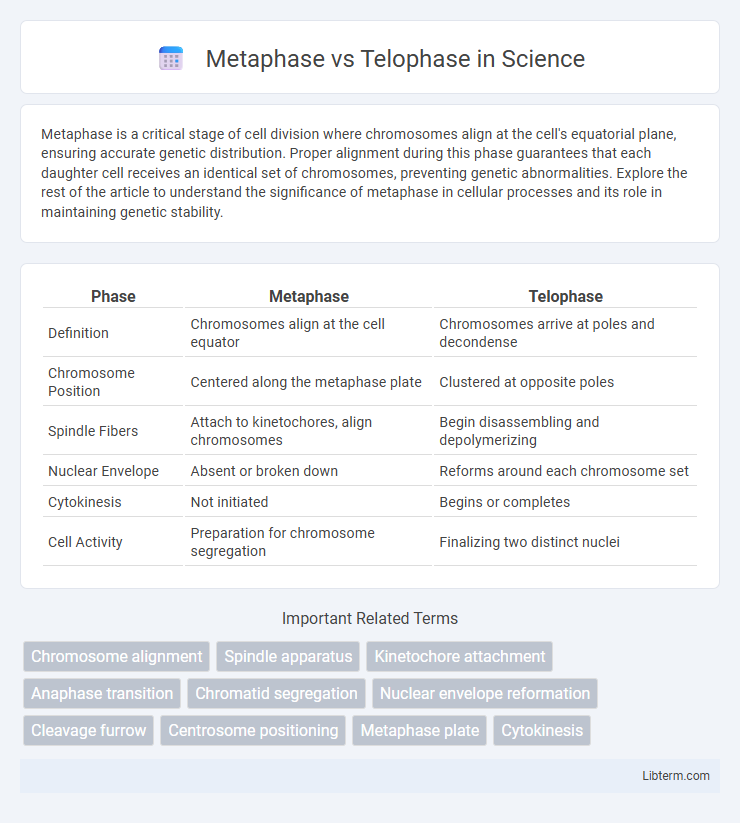Metaphase is a critical stage of cell division where chromosomes align at the cell's equatorial plane, ensuring accurate genetic distribution. Proper alignment during this phase guarantees that each daughter cell receives an identical set of chromosomes, preventing genetic abnormalities. Explore the rest of the article to understand the significance of metaphase in cellular processes and its role in maintaining genetic stability.
Table of Comparison
| Phase | Metaphase | Telophase |
|---|---|---|
| Definition | Chromosomes align at the cell equator | Chromosomes arrive at poles and decondense |
| Chromosome Position | Centered along the metaphase plate | Clustered at opposite poles |
| Spindle Fibers | Attach to kinetochores, align chromosomes | Begin disassembling and depolymerizing |
| Nuclear Envelope | Absent or broken down | Reforms around each chromosome set |
| Cytokinesis | Not initiated | Begins or completes |
| Cell Activity | Preparation for chromosome segregation | Finalizing two distinct nuclei |
Introduction to Cell Division
Metaphase ensures chromosomes align at the cell's equatorial plate, facilitating accurate genetic material segregation during cell division. Telophase follows by reassembling the nuclear envelope around each set of separated chromosomes, marking the near completion of mitosis. These phases are critical for maintaining genomic stability and proper cell function during division.
Overview of Mitosis Stages
Metaphase in mitosis is characterized by chromosomes aligning at the cell's equatorial plate, ensuring accurate segregation during cell division. Telophase follows, marked by the reformation of the nuclear envelope around separated chromosome sets and the beginning of cytokinesis. These stages are critical for maintaining genetic integrity and successful cell replication.
What is Metaphase?
Metaphase is a key stage in mitosis where chromosomes align at the cell's equatorial plate, ensuring accurate genetic segregation. During this phase, spindle fibers attach to the centromeres of chromosomes, facilitating their precise alignment and attachment. Proper metaphase alignment is critical for the equal distribution of duplicated chromosomes into daughter cells, preventing genetic abnormalities.
Key Events During Metaphase
In metaphase, chromosomes align at the cell's equatorial plane, forming the metaphase plate, essential for accurate chromosome segregation. The spindle fibers attach to the centromeres of each chromosome via kinetochores, ensuring proper tension and orientation. This precise alignment and attachment are critical for the subsequent transition to anaphase, preventing genetic abnormalities.
What is Telophase?
Telophase is the final stage of mitosis during which the chromosomes arrive at opposite poles of the cell and begin to de-condense, transitioning back into chromatin. This phase is characterized by the reformation of the nuclear envelope around each set of separated chromosomes, effectively creating two distinct nuclei. Cytokinesis often begins during telophase, leading to the physical separation of the cytoplasm into two daughter cells.
Key Events During Telophase
Telophase is characterized by the reformation of the nuclear envelope around the separated sister chromatids, now individual chromosomes, as they reach opposite poles of the cell. Chromosomes begin to decondense, transitioning from their tightly coiled state back into a more relaxed chromatin form, which facilitates gene expression and preparation for the next cell cycle phase. The nucleolus also reappears, and the spindle fibers disassemble, marking the near completion of mitosis before cytokinesis divides the cytoplasm.
Metaphase vs Telophase: Main Differences
Metaphase is characterized by chromosomes aligning at the metaphase plate, ensuring proper attachment to spindle fibers, while telophase involves the reformation of the nuclear envelope around separated chromatids. During metaphase, chromosomes are highly condensed and aligned centrally, whereas in telophase, chromosomes begin to decondense as the cell prepares for cytokinesis. The key difference lies in metaphase's role in chromosome alignment for segregation, compared to telophase's role in completing nuclear division and initiating cell division.
Structural Changes in Chromosomes
During metaphase, chromosomes align at the cell's equatorial plate, each consisting of two sister chromatids tightly coiled and attached at the centromere, ensuring proper segregation. In telophase, chromatids arrive at opposite poles and begin to decondense from their compact form into extended chromatin. This transition marks the reformation of the nuclear envelope around each set of chromosomes, signifying the end of chromosomal movement and preparation for cytokinesis.
Importance of Metaphase and Telophase in Cell Cycle
Metaphase ensures chromosomes align at the metaphase plate, guaranteeing equal segregation of genetic material, which is crucial for genetic stability during cell division. Telophase facilitates the reformation of the nuclear envelope around separated chromatids, marking the end of mitosis and preparing the cell for cytokinesis. Both phases are essential for accurate chromosome distribution and successful completion of the cell cycle, maintaining cellular function and organismal development.
Conclusion: Comparing Metaphase and Telophase
Metaphase aligns chromosomes at the cell's equatorial plate, ensuring accurate chromosome segregation, while telophase completes cell division by reforming nuclear membranes and decondensing chromosomes. The precise chromosome arrangement during metaphase sets the stage for telophase's structural reorganization, highlighting their sequential but distinct roles in mitosis. Efficient progression from metaphase to telophase is critical for genetic stability and successful cell proliferation.
Metaphase Infographic

 libterm.com
libterm.com